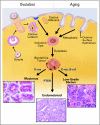New insights into the pathogenesis of serous ovarian cancer and its clinical impact
- PMID: 18854563
- PMCID: PMC2652087
- DOI: 10.1200/JCO.2008.18.1107
New insights into the pathogenesis of serous ovarian cancer and its clinical impact
Abstract
There are only a handful of concepts concerning cancer and carcinogenesis that are currently beyond dispute. One such dogma is the adenoma-carcinoma sequence and that a multistep accumulation of genetic alterations is required for transformation from a benign to a neoplastic tissue. The inevitable derivative of this dogma is that every invasive carcinoma is in fact a missed intraepithelial tumor, and furthermore, a late evolutionary stage in the sequence of development from a precursor lesion. Until fairly recently, high-grade serous ovarian carcinoma seemed to be one of the only known deviants of these concepts. In this article, we discuss the emergence of the fallopian tube fimbria as a field of origin for high-grade serous carcinomas and present a binary model of ovarian cancer pathogenesis that takes into consideration prior epidemiologic, morphologic, and genetic data. With the rise of the fallopian tube secretory epithelial cell as a cell of origin for high-grade pelvic serous carcinomas, the need to develop tools and model systems to characterize the biology and physiology of this cell is recognized.
Figures




References
-
- Halazonetis TD, Gorgoulis VG, Bartek J: An oncogene-induced DNA damage model for cancer development. Science 319:1352-1355, 2008 - PubMed
-
- Bartkova J, Rezaei N, Liontos M, et al: Oncogene-induced senescence is part of the tumorigenesis barrier imposed by DNA damage checkpoints. Nature 444:633-637, 2006 - PubMed
-
- Jackman RJ, Mayo CW: The adenoma-carcinoma sequence in cancer of the colon. Surg Gynecol Obstet 93:327-330, 1951 - PubMed
-
- Vogelstein B, Kinzler KW: The multistep nature of cancer. Trends Genet 9:138-141, 1993 - PubMed
-
- Bartkova J, Horejsi Z, Koed K, et al: DNA damage response as a candidate anti-cancer barrier in early human tumorigenesis. Nature 434:864-870, 2005 - PubMed
Publication types
MeSH terms
Grants and funding
LinkOut - more resources
Full Text Sources
Other Literature Sources
Medical

